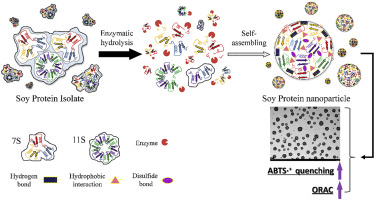当前位置:
X-MOL 学术
›
Food Hydrocoll.
›
论文详情
Our official English website, www.x-mol.net, welcomes your
feedback! (Note: you will need to create a separate account there.)
Formation and characterization of soy protein nanoparticles by controlled partial enzymatic hydrolysis
Food Hydrocolloids ( IF 11.0 ) Pub Date : 2020-08-01 , DOI: 10.1016/j.foodhyd.2020.105844 Penghui Shen , Feibai Zhou , Yuanhong Zhang , Dan Yuan , Qiangzhong Zhao , Mouming Zhao
Food Hydrocolloids ( IF 11.0 ) Pub Date : 2020-08-01 , DOI: 10.1016/j.foodhyd.2020.105844 Penghui Shen , Feibai Zhou , Yuanhong Zhang , Dan Yuan , Qiangzhong Zhao , Mouming Zhao

|
Abstract In the present study, the potential of enzymatic hydrolysis as an efficient approach for the fabrication of soy protein nanoparticles (SPNPs) was investigated. Three types of enzymes including Flavorzyme, Alcalase and Protamex were selected to hydrolyze soy protein isolate (SPI) to different degrees (DH, 3%, 7% and 11%). Both the enzymes used and the DH obtained were vital for nanoparticle formation. The fabricated SPNPs were spherical and showed homogeneous size distributions with z-average size between 80 and 170 nm. Mechanisms involved in the formation of SPNPs were discussed by evaluating changes in SDS-PAGE patterns, secondary structures and interactive forces maintaining particle structure. Results suggested that the main subunits of 7S and 11S were retained in SPNPs, where hydrophobic interactions mainly dominated their structure formation, along with hydrogen bonds and disulfide bonds stabilizing the external and internal structure of nanoparticles, respectively. Secondary structure analysis implied that the ratio of α-helix to β-sheet in SPNPs was in a narrow range of around 45%, and a transition from α-helix to β-sheet was impeditive for nanoparticle formation. Compared with native SPI, the SPNPs showed more rapid adsorptions toward the oil-water interface, suggesting the potential good emulsifying property. Meanwhile, enhanced surface hydrophobicity and hydrolysis of α′α subunits into polypeptides endowed SPNPs with superior antioxidative capacity. These findings are expected to expand the potential of partial enzymatic hydrolysis as an efficient strategy to design and construct multifunctional soy protein nanoparticles for foods, cosmetics, and pharmaceutical applications.
中文翻译:

通过可控部分酶水解制备大豆蛋白纳米颗粒并对其进行表征
摘要 在本研究中,研究了酶水解作为制备大豆蛋白纳米颗粒 (SPNP) 的有效方法的潜力。选择 Flavorzyme、Alcalase 和 Protamex 三种酶对大豆分离蛋白(SPI)进行不同程度的水解(DH、3%、7% 和 11%)。使用的酶和获得的 DH 对纳米颗粒的形成至关重要。制造的 SPNP 是球形的,并显示出均匀的尺寸分布,z 平均尺寸在 80 到 170 nm 之间。通过评估 SDS-PAGE 模式、二级结构和维持粒子结构的相互作用力的变化,讨论了参与 SPNP 形成的机制。结果表明 7S 和 11S 的主要亚基保留在 SPNPs 中,其中疏水相互作用主要支配它们的结构形成,氢键和二硫键分别稳定纳米粒子的外部和内部结构。二级结构分析表明,SPNPs中α-螺旋与β-折叠的比例在45%左右的狭窄范围内,并且从α-螺旋到β-折叠的转变阻碍了纳米颗粒的形成。与天然 SPI 相比,SPNPs 对油水界面的吸附速度更快,表明其具有潜在的良好乳化性能。同时,增强的表面疏水性和 α'α 亚基水解成多肽赋予 SPNP 优异的抗氧化能力。
更新日期:2020-08-01
中文翻译:

通过可控部分酶水解制备大豆蛋白纳米颗粒并对其进行表征
摘要 在本研究中,研究了酶水解作为制备大豆蛋白纳米颗粒 (SPNP) 的有效方法的潜力。选择 Flavorzyme、Alcalase 和 Protamex 三种酶对大豆分离蛋白(SPI)进行不同程度的水解(DH、3%、7% 和 11%)。使用的酶和获得的 DH 对纳米颗粒的形成至关重要。制造的 SPNP 是球形的,并显示出均匀的尺寸分布,z 平均尺寸在 80 到 170 nm 之间。通过评估 SDS-PAGE 模式、二级结构和维持粒子结构的相互作用力的变化,讨论了参与 SPNP 形成的机制。结果表明 7S 和 11S 的主要亚基保留在 SPNPs 中,其中疏水相互作用主要支配它们的结构形成,氢键和二硫键分别稳定纳米粒子的外部和内部结构。二级结构分析表明,SPNPs中α-螺旋与β-折叠的比例在45%左右的狭窄范围内,并且从α-螺旋到β-折叠的转变阻碍了纳米颗粒的形成。与天然 SPI 相比,SPNPs 对油水界面的吸附速度更快,表明其具有潜在的良好乳化性能。同时,增强的表面疏水性和 α'α 亚基水解成多肽赋予 SPNP 优异的抗氧化能力。











































 京公网安备 11010802027423号
京公网安备 11010802027423号